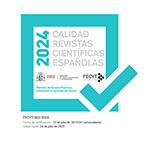Sub-Saharan women trafficked for sexual exploitation: A transdisciplinary approach from the paradigm of resilience
Abstract
Introduction. Human trafficking for the purpose of sexual exploitation is a growing social problem in today’s democratic societies, affecting mainly girls and women (Eurostat, 2018). It is also a crime (Palermo protocol [UN, 2000]), a violation of human rights, and a manifestation of gender-based violence (UN’s Declaration on the Elimination of Violence against Women [UN, 1993]), and a type of slavery (Correa, 2011) against the most impoverished women. Purpose. In this article, we focus on the sub-Saharan trafficked women who come to southern Europe via the human trafficking routes that cross northern Africa going through places such as Lagos, Tinzaouaten (Mali), Tamanrrasset (Argelia), the Sahara Desert, and different Moroccan cities, before reaching Europe over the Southern Spanish coastline. Ew show the resources used by these women when going through the said contexts of exploitation and forced prostitution. Methodology. Our research reviews the existing literature taking resilience as a pivotal point that is present in various areas of knowledge, including psychology and literature, among others. It allows us to show a change of perspective in this matter, by making these women visible in terms of their capacities. Results. We show examples, from different fields of knowledge and disciplines, of women who, having lived in these contexts, have carried out processes of fortitude, recovery, and personal growth. A new glimpse of this phenomenon and of these processes is studied, from a scarcely researched perspective to this day. Contribution. The originality of this analysis contributes a new understanding of the capacity of resilience of this population, despite the adverse conditions of their migratory experience
Downloads
Article download
License
In order to support the global exchange of knowledge, the journal Investigaciones Feministas is allowing unrestricted access to its content as from its publication in this electronic edition, and as such it is an open-access journal. The originals published in this journal are the property of the Complutense University of Madrid and any reproduction thereof in full or in part must cite the source. All content is distributed under a Creative Commons Attribution 4.0 use and distribution licence (CC BY 4.0). This circumstance must be expressly stated in these terms where necessary. You can view the summary and the complete legal text of the licence.











